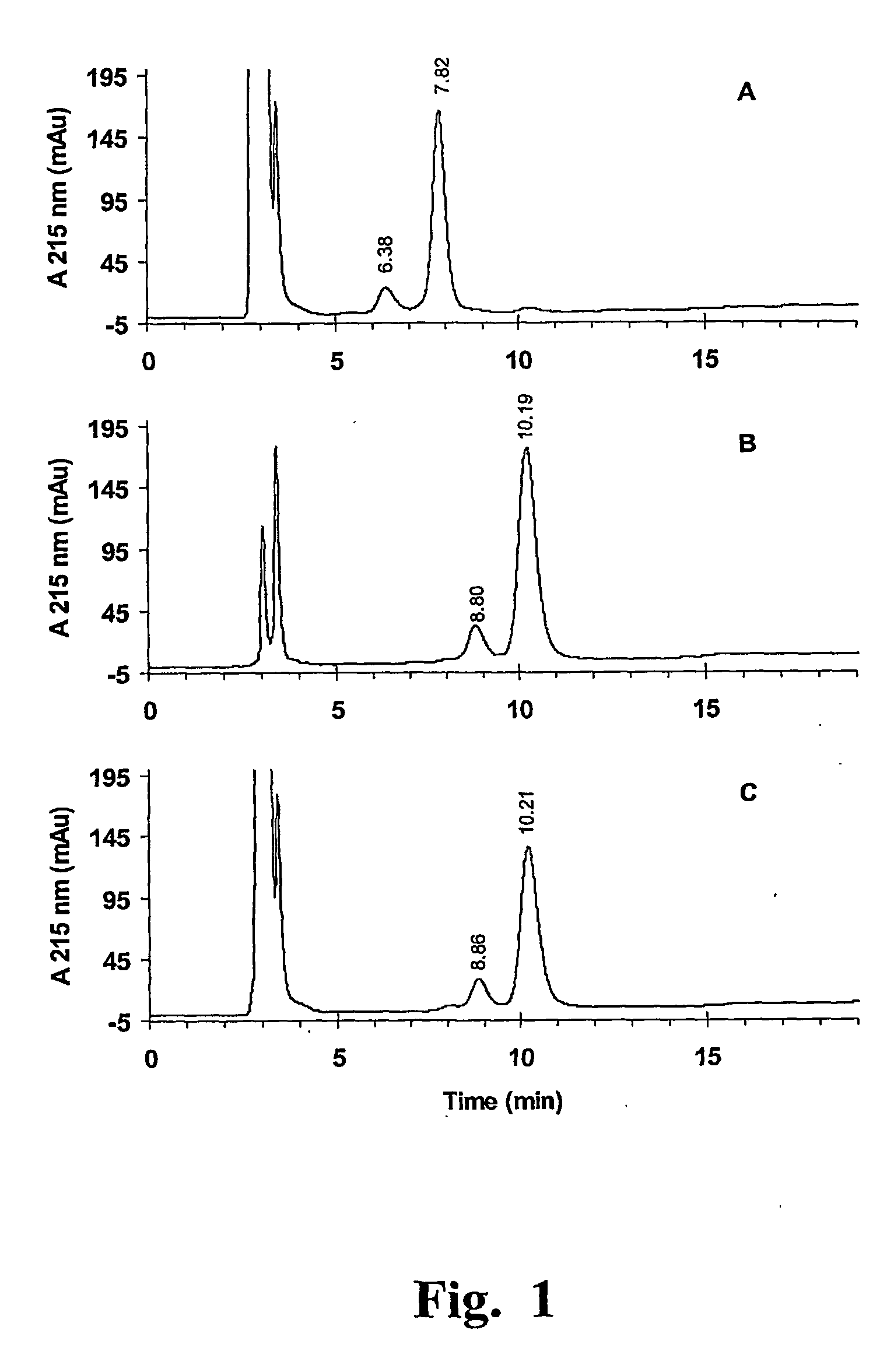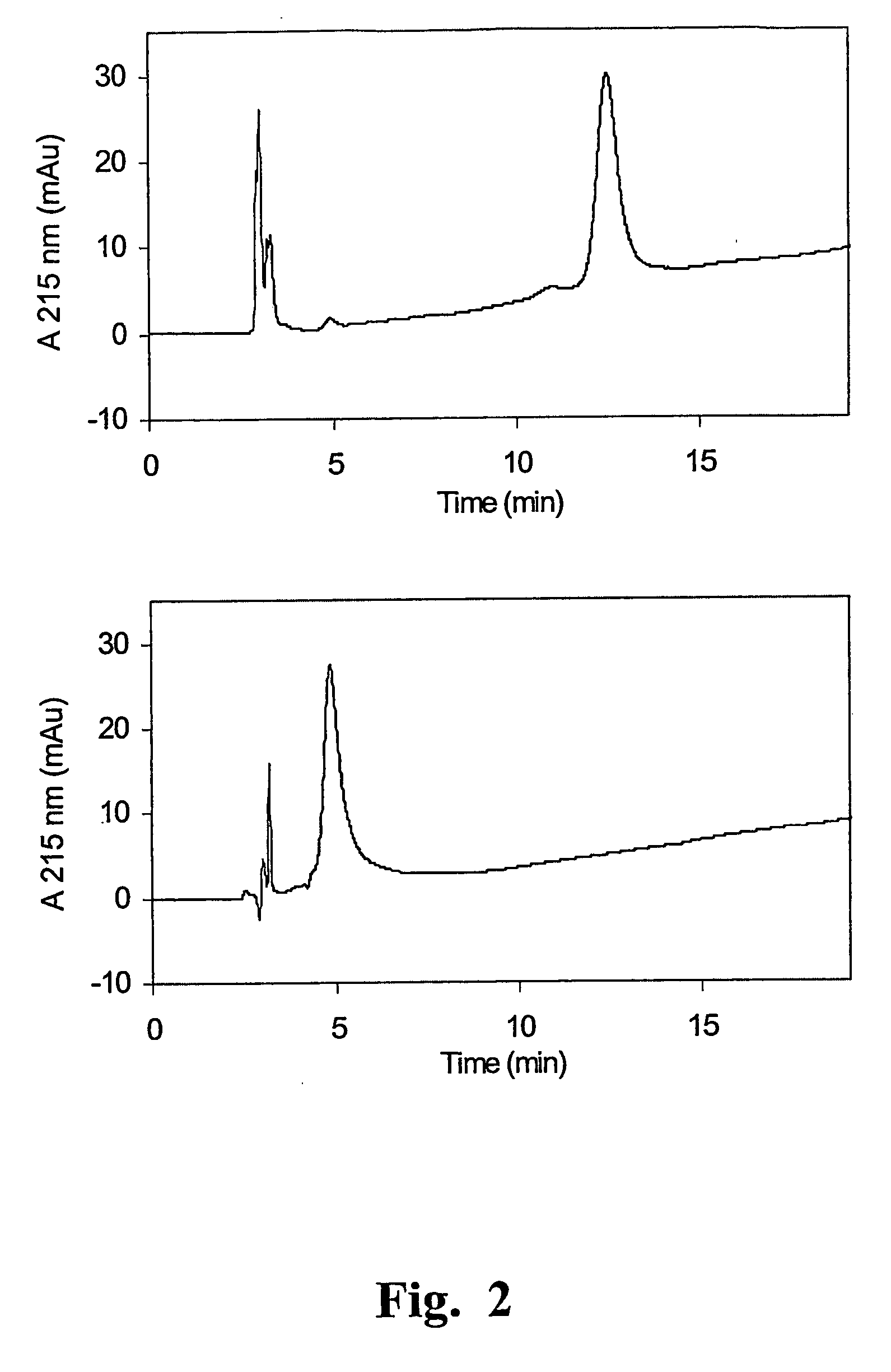Method for the selective and quantitative functionalization of immunoglobulin fab fragments, conjugate compounds obtained with the same and compositions thereof
a technology of immunoglobulin fab fragment and conjugate compound, which is applied in the field of conjugate compound obtained with the same, can solve the problems of limiting the therapeutic efficacy not useful for obtaining final products, etc., and achieves the effect of reducing the number of antigenic binding sites
- Summary
- Abstract
- Description
- Claims
- Application Information
AI Technical Summary
Benefits of technology
Problems solved by technology
Method used
Image
Examples
example 1
[0091] Reduction and alkylation of a recombinant anti-Herpes simplex virus Fab with β-maleimidopropionic acid.
[0092] A model reaction system was established in order to test several reaction conditions and to easily characterize the reaction products. A commercially available maleimido derivative endowed with a ionizable group, β-maleimidopropionic acid (following compound of formula I), was
[0093] selected as a model compound, which allowed the evaluation of the number of conjugated moieties by a simple ion-exchange chromatography
[0094] analysis, together with MS analysis
[0095] The optimised procedure was the following one:
[0096] One volume V of a 2 mM TCEP solution was prepared by 1 to 250 dilution of the 0.5 M commercial product (Pierce) in a thoroughly deareated buffer containing 50 mM Tris-HCl, 5 mM EDTA at pH=7.0. Then, this solution was added to an equivalent volume V of a 10 μM solution of the rFab of the title (prepared according to the previously mentioned Cattani P e...
example 2
Synthesis of N2,N2-bis[2-[bis(carboxymethyl)amino]ethyl]-N6-[4-(2,5-dioxo-1H-pyrrol-1-yl)-1-oxobutyl]-L-lysine (Compound D).
[0100] The compound of the title was synthesised starting from compound A (which was prepared according to “Anelli, P. L. et al.; Bioconjugate Chem. 1999, 10, 137-140”) following the two steps scheme below:
[0101] First Step:
[0102] Isobutyl chloroformate (15 mmol) was dropped into a solution of 4-maleimidobutyric acid of commercial source (Compound B; 13.6 mmol) and triethylamine (15 mmol) in tetrahydrofuran (55 mL) at −15° C., under nitrogen atmosphere. After 15 min, a solution of compound A (13.6 mmol), prepared as previously disclosed, in tetrahydrofuran (20 mL) was dropped therein, while keeping the temperature at 4° C. After 15 min cooling was interrupted and the mixture was stirred at room temperature for 1 h, then evaporated under vacuum. The residue was dissolved in ethyl acetate (50 mL), then washed with water. The organic phase was then dried over s...
example 3
[0107] Selective Reduction of the rFab Inter-Chain Disulfide
[0108] Reduction of one volume V of the 10 μM rFab solution of Example 1 was carried out with an equivalent volume V of a 5 mM TCEP solution in 100 mM acetate buffer at pH=5, for 1 h at 37° C. As much oxygen as possible was removed from the reaction medium by bubbling nitrogen through the buffering agent before use. Under these conditions, the reduction of the inter-chain disulfide was substantially complete, as observed by SDS-PAGE analysis. However, rFab conformation was not lost as evidenced by the fact that, removing the reducing agent and incubating the reduced rFab for 2 h in 0.1 M Tris-HCl at pH=8, the inter-chain disulfide was formed again. This fact is very important, meaning that the final product will maintain the capability of recognising the reactive site of the antigen.
PUM
| Property | Measurement | Unit |
|---|---|---|
| molar ratio | aaaaa | aaaaa |
| molar ratio | aaaaa | aaaaa |
| Reaction time | aaaaa | aaaaa |
Abstract
Description
Claims
Application Information
 Login to View More
Login to View More - R&D
- Intellectual Property
- Life Sciences
- Materials
- Tech Scout
- Unparalleled Data Quality
- Higher Quality Content
- 60% Fewer Hallucinations
Browse by: Latest US Patents, China's latest patents, Technical Efficacy Thesaurus, Application Domain, Technology Topic, Popular Technical Reports.
© 2025 PatSnap. All rights reserved.Legal|Privacy policy|Modern Slavery Act Transparency Statement|Sitemap|About US| Contact US: help@patsnap.com



